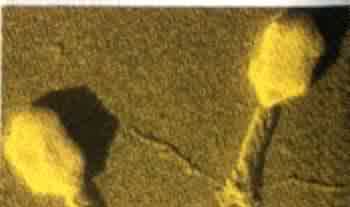Reproduction
and Evolution
Scientists first learned about
virus reproduction by studying bacteriophages,
viruses that infect bacteria. Phages (PA Yiuz),
as they are called, can be easily studied because
their bacterial hosts multiply quickly in cell
cultures.
The most commonly studied phages
are those of the T group. They are named Ti, T2,
T3, and so forth. The Tphages infect the
bacterium Escherichia coli, the common bacterium
of the human digestive tract. The T-even phages
(T2, T4, T6) are virulent. They are capable of
destroying E. coli cells.
Examine the structure of the T4
phage in Figure 19-3. Notice that its morphology
is different from that of the viruses described
in Section 19.1. DNA in the viral core is
surrounded by a protein coat that forms a
polyhedron. Beneath the head is a collar of
protein and a sheath that rests on a base plate.
Tail fibers emerge from the base plate. As you
read about the reproduction of the T4 phage,
notice how the structure of the virus suits its
function.
The Lytic Cycle
The lytic cycle is a fundamental
reproductive process in viruses. The term lyse
means to "break open," a reference to
the liberation of the new viral particles from
the host cell. The T4 phage reproduces by the
lytic cycle and thus can serve as an example of
viral reproduction. The lytic cycle has five
phases, each of which is continuous with the
others. The phases are adsorption, entry,
replication, assembly, and release. Study Figure
19-4 as you read.
1. During adsorption the virus
attaches itself to a specific host cell. The tail
fibers of the virus contain proteins that have a
chemical affinity with the bacterial cell wall.
In fact, specific areas of the wall, called
receptor sites, are the places where the virus
attaches itself.
2. During entry the T4 phage
releases an enzyme that weakens a spot in the
cell wall of the host. Then, much like a
hypodermic needle, the T4 presses its sheath
against the cell and injects its

![]()